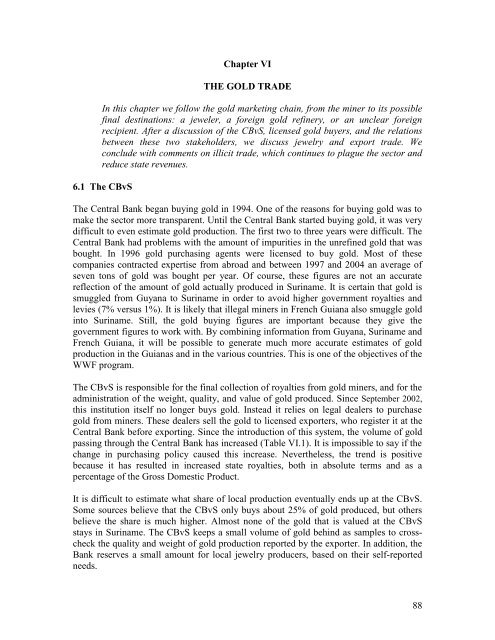SITUATION ANALYSIS OF THE SMALL-SCALE GOLD ... - WWF
SITUATION ANALYSIS OF THE SMALL-SCALE GOLD ... - WWF
SITUATION ANALYSIS OF THE SMALL-SCALE GOLD ... - WWF
You also want an ePaper? Increase the reach of your titles
YUMPU automatically turns print PDFs into web optimized ePapers that Google loves.
Chapter VI<br />
<strong>THE</strong> <strong>GOLD</strong> TRADE<br />
In this chapter we follow the gold marketing chain, from the miner to its possible<br />
final destinations: a jeweler, a foreign gold refinery, or an unclear foreign<br />
recipient. After a discussion of the CBvS, licensed gold buyers, and the relations<br />
between these two stakeholders, we discuss jewelry and export trade. We<br />
conclude with comments on illicit trade, which continues to plague the sector and<br />
reduce state revenues.<br />
6.1 The CBvS<br />
The Central Bank began buying gold in 1994. One of the reasons for buying gold was to<br />
make the sector more transparent. Until the Central Bank started buying gold, it was very<br />
difficult to even estimate gold production. The first two to three years were difficult. The<br />
Central Bank had problems with the amount of impurities in the unrefined gold that was<br />
bought. In 1996 gold purchasing agents were licensed to buy gold. Most of these<br />
companies contracted expertise from abroad and between 1997 and 2004 an average of<br />
seven tons of gold was bought per year. Of course, these figures are not an accurate<br />
reflection of the amount of gold actually produced in Suriname. It is certain that gold is<br />
smuggled from Guyana to Suriname in order to avoid higher government royalties and<br />
levies (7% versus 1%). It is likely that illegal miners in French Guiana also smuggle gold<br />
into Suriname. Still, the gold buying figures are important because they give the<br />
government figures to work with. By combining information from Guyana, Suriname and<br />
French Guiana, it will be possible to generate much more accurate estimates of gold<br />
production in the Guianas and in the various countries. This is one of the objectives of the<br />
<strong>WWF</strong> program.<br />
The CBvS is responsible for the final collection of royalties from gold miners, and for the<br />
administration of the weight, quality, and value of gold produced. Since September 2002,<br />
this institution itself no longer buys gold. Instead it relies on legal dealers to purchase<br />
gold from miners. These dealers sell the gold to licensed exporters, who register it at the<br />
Central Bank before exporting. Since the introduction of this system, the volume of gold<br />
passing through the Central Bank has increased (Table VI.1). It is impossible to say if the<br />
change in purchasing policy caused this increase. Nevertheless, the trend is positive<br />
because it has resulted in increased state royalties, both in absolute terms and as a<br />
percentage of the Gross Domestic Product.<br />
It is difficult to estimate what share of local production eventually ends up at the CBvS.<br />
Some sources believe that the CBvS only buys about 25% of gold produced, but others<br />
believe the share is much higher. Almost none of the gold that is valued at the CBvS<br />
stays in Suriname. The CBvS keeps a small volume of gold behind as samples to crosscheck<br />
the quality and weight of gold production reported by the exporter. In addition, the<br />
Bank reserves a small amount for local jewelry producers, based on their self-reported<br />
needs.<br />
88
















